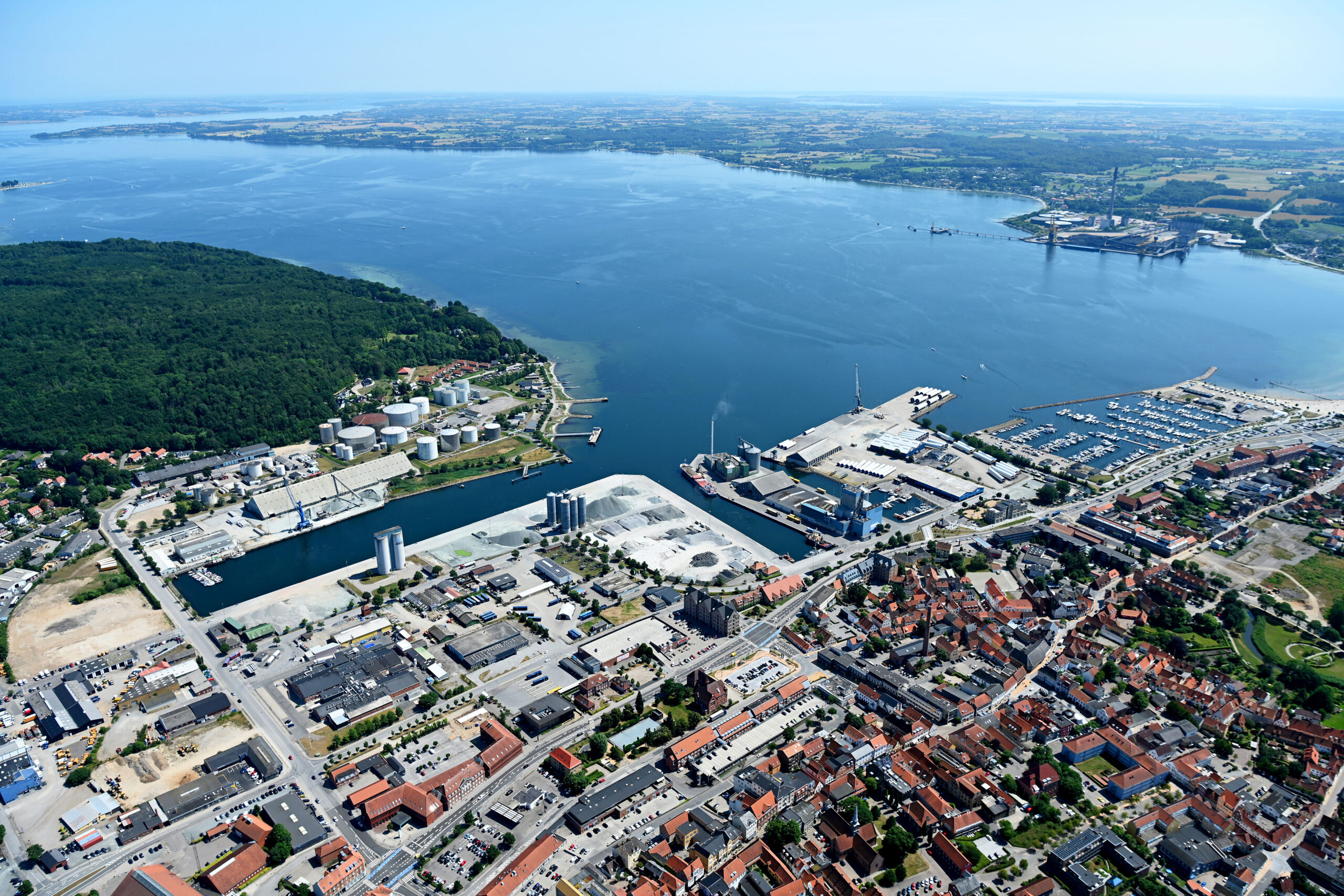Rekordresultat fra Aabenraa Havn

Aabenraa Havn slår alle rekorder i sit netop offentliggjorte årsregnskab og baner vejen for Aabenraa som fyrtårn i Danmarks grønne omstilling.
2021 har været endnu et rekordår for Aabenraa Havn. Omsætningen er steget 27% fra 31.507.453 kr. i 2020 til rekordhøje 40.066.161 kr. i 2021. Også antallet af skibe, der årligt anløber havnen og den godsmængde, der håndteres, er stedet markant. Næsten 400 skibe er således anløbet havnen, der i 2021 har ekspederet 1.912.374 tons gods over kaj. Det svarer til 3,6 tons gods i minuttet hver dag året rundt.
Det flotte resultat skyldes især stigning i det såkaldte bulkgods, der er fast eller flydende gods, der transporteres upakket som f.eks. korn, skærver, cement og biomasse.
– Aabenraa Havn er Sønderjyllands eneste erhvervshavn, og både sønderjysk og nordtysk erhverv og landbrug er afhængig af transport via havnen og søvejen. Flere end 2.000 arbejdspladser er betinget af det gods, vi får over kaj, og det er det, som kan aflæses af årsresultatet, siger Henrik Thykjær, der er er direktør for Aabenraa Havn.
Det er især råstoffer til bygge- og anlægsbranchen, der positivt har påvirket havnens resultat, ligesom Danmarks grønne omstilling sætter sit tydelige aftryk på regnskabet. Mængden af råstoffer, materialer og komponenter til Danmarks nye grønne infrastruktur baseret på vedvarende energikilder som vind- og solcelleparker er nemlig også steget markant.
Af national interesse
Selvom Aabenraa blot er Danmarks 57. største by, er byens havn Danmarks 8. største godshavn, og interessen for Aabenraa Havn er støt stigende.
– Mange af havnens virksomheder er virksomheder af såkaldt national interesse. Det betyder, at de råstoffer, de transporterer via havnen, er helt afgørende for det danske produktionsapparat og landets sammenhængskraft. I takt med, at andre byer i regionen enten har afviklet eller har planer om at afvikle deres erhvervshavne til fordel for havnært boligbyggeri, kan vi tydeligt mærke, hvor vigtig Aabenraa Havn er for dansk infrastruktur og den bevågenhed, det giver fra f.eks. myndigheder, interesseorganisationer og erhvervsliv, fortæller Henrik Thykjær.
Traditionel havnedrift og grøn omstilling går hånd i hånd
Havnens rekordomsætning er alene båret af den traditionelle havnedrift på Aabenraa Havn. De nye arealer ved Ensted Havn, som Aabenraa Havn i 2021 endelig kunne overtage, er nemlig en investering i fremtiden og i nye former for havneaktiviteter.
– Som havn er Ensted Havn meget anderledes fra Aabenraa Havn. Ensted har f.eks. langt færre kajnære arealer end Aabenraa Havn, og når vi taler gods og bulk er kajnære arealer altafgørende. Så derfor egner Ensted sig ikke til det, der i dag er Aabenraa Havns kerneforretning og eksistensgrundlag. Til gengæld er arealerne ved Ensted perfekte til helt nye forretningsområder som f.eks. power-to-x og recycling. Så Ensted er en investering i nye forretningsområder, der kan supplere den fortsatte traditionelle havnedrift, forklarer Henrik Thykjær.
Både havnens nuværende aktiviteter og fremtidens nye forretningsområder har den grønne omstilling som fælles omdrejningspunkt.
– Søvejen er suverænt den mest miljøvenlige transportform, og det har stor betydning for både virksomhedernes og Sønderjyllands co2-regnskab. Hvis vi ikke havde havnen i Aabenraa, skulle samme godsmængde i stedet transporteres af mere end 55.000 lastbiler. Samtidig er transporten af f.eks. vindmøllekomponenter og biomasse via havnen en forudsætning for den fortsatte udbygning af den grønne infrastruktur. Imens har de kommende virksomheder på Ensteds fokus på at udvikle fremtidens nye grønne energi- og brændselsformer. Så Aabenraa Havn og Ensted Havn supplerer hinanden rigtig godt, og udviklingen af begge havne går hånd i hånd, siger Henrik Thykjær.
Aabenraas fyrtårn
Aabenraa Havn spås af både myndigheder, erhvervsliv og brancheforeninger en nøglerolle i den grønne omstilling og kan i fremtiden sætte Aabenraa på landkortet som et førende grønt forsynings- og udviklingshub.
– Udviklingen har betydet, at vi i Aabenraa har fået spillet utrolig stærke kort på hånden: Vores havn er landsdelens eneste tilbageværende erhvervshavn og direkte adgang til den blå motorvej. Ensted har desuden ideelle rammer for bl.a. power-to-x, og begge havne ligger strategisk perfekt i forhold til logistik og forsyning. Der er således et stort potentiale i at udnytte de mange snitflader og i endnu højere grad tænke havnene sammen med Padborg Transportcenter, der er Nordeuropas største transportcenter. Så nu bliver det spændende at se, hvordan Aabenraa kommune vælger at spille kortene i den nye ejerstrategi for havnen, der er under udarbejdelse, siger Erwin Andresen, der er bestyrelsesformand for Aabenraa Havn.
Aabenraa Havn er 100 % ejet af Aabenraa Kommune, og derfor er det alene kommunen, der sætter rammerne for den strategiske retning for havnens udvikling. Der forventes et førsteudkast til den nye ejerstrategi i løbet af de kommende måneder.
– Vi håber selvfølgelig, at kommunen og byrådet én gang for alle træffer en strategisk beslutning om, at havnen skal være Aabenraas grønne fyrtårn og dermed udnytte alle de muligheder, det reelt giver for tiltrækning af virksomheder, arbejdspladser, uddannelser og indbyggere. På havnen er vi i hvert fald helt klar til at blive en del af et kommunalt fyrtårn og står med et rekordregnskab og solide fremtidsperspektiver stærkere end nogen sinde før, slutter Erwin Andresen.
